Test your skills in 10 emergency scenarios
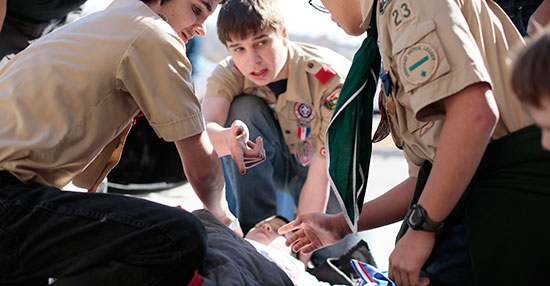
Studying the First Aid merit badge pamphlet is great, but to really Be Prepared you need to put everything you think you know to the test.
That’s the idea behind the First Aid Meet, an event where Scouts compete to see who handles high-pressure first-aid situations the best.
The scenarios might not be real, but they try to simulate many of the factors in real-life emergency situations, such as time constraints, pressure-packed predicaments and, most of all, the ability to make the right decisions when treating an injured person.
Test your first aid and emergency response skills with the following scenarios.
Scenario No. 1
On a hike through a park, you come across a man walking in a patch of plants with leaves that are grouped in threes. When you ask him if he’s OK, he points out a red rash on his arms and legs. What do you think is going on?
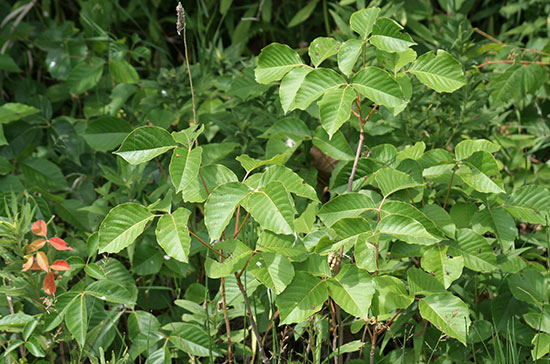
How to handle the situation:
1. The man has likely come in contact with poison ivy.
2. Avoid touching the poison ivy yourself! Make sure the scene is safe. Identify yourself as being trained in first aid and ask if he wants you to help.
3. Move the victim away from the plants. Wear gloves to prevent contact with the sap of the plant. Treat by wiping the area with rubbing alcohol and then apply calamine or another soothing lotion.
4. Keep the man calm.
5. Make sure the victim has suffered no other injuries.
Scenario No. 2
On a Boy Scout hike in very hot weather, you come across a man who looks very pale and weak and is breathing rapidly. His skin is extremely warm to the touch, he seems confused and irritable, and his speech is not clear. You notice his water bottle is empty.

How to handle the situation:
1. It appears the man is suffering from heatstroke. Make sure the scene is safe. Identify yourself as being trained in first aid and ask if he wants help. If he’s confused, this could be difficult.
2. Have one member of your unit call 911 while the others tend to the victim. Stay on the phone with the operator until help arrives. When paramedics arrive, have someone direct them to the scene and be prepared to communicate what happened.
3. This is a true emergency. The man must be cooled to keep him alive. Get him to a shady spot, fan him to cool him off and have him sip water. If you have them, apply ice packs or water-soaked compresses under his armpits and on his neck. Have him take off excess clothing.
4. Treat the man for shock.
5. Make a thorough examination to make sure there are no hidden injuries.
Scenario No. 3
On a hike at extreme elevation, an adult leader starts experiencing headaches, shortness of breath and dizziness. He then falls to the ground and throws up.
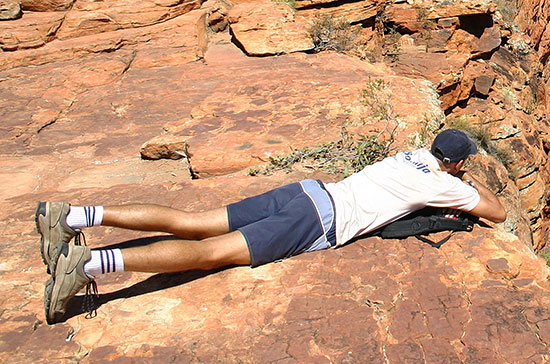
How to handle the situation:
1. It looks like the leader is suffering from altitude sickness.
2. Wear gloves if you must come in contact with bodily fluids. Help the victim to a lower elevation. He will likely be unsteady and will need support walking down the mountain; you may have to carry him or build a stretcher with logs and a T-shirt if necessary.
3. Give the victim small sips of water.
4. Treat the victim for shock. Continually communicate with him to see if he’s feeling better or worse. Monitor continuously for any other medical issues.
5. The symptoms of altitude sickness usually subside shortly once you reach a lower altitude. If the leader continues to feel ill, call 911 and wait for paramedics.
Scenario No. 4
On a walk through your neighborhood with friends, you find a man lying on the ground under a ladder. He is in obvious pain and his arm is clearly broken, with a piece of bone protruding from the skin.
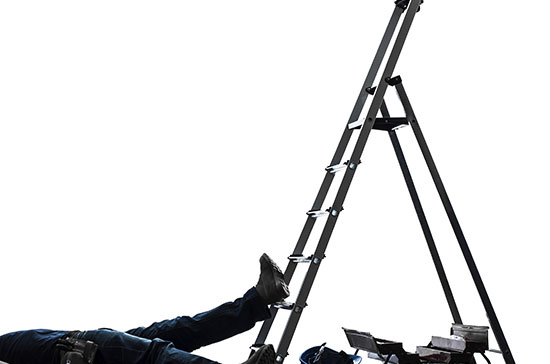
How to handle the situation:
1. It appears that the man has fallen from the ladder. Make sure it’s safe to approach. Is there anyone else on the ladder? Is the ladder in a stable position? Are there any obstacles on the ground or above, such as electrical wires or tree limbs? Identify yourself as being trained in first aid and offer assistance.
2. Have one friend call 911 and stay on the phone with the operator until help arrives. When paramedics arrive, have someone direct them to the scene and be prepared to communicate what happened.
3. Wear gloves and goggles if you have them. Provide urgent treatment for the victim by controlling the bleeding with a sterile gauze around the wound. (If you don’t have gauze and the man is bleeding severely, use the cleanest cloth you have.) Do not use pressure on the bone itself but do your best to control the bleeding. Do not try to clean the wound. You will need a second person to protect the spinal column by supporting the victim’s head and neck in the position in which he was found.
4. Treat the victim for shock, but don’t move his legs because of a possible spinal injury. Keep him calm.
5. Thoroughly examine the victim to make sure there are no hidden injuries. For example, did he hit his head when he fell? What about his legs and ankles?
Scenario No. 5
While hanging out in your backyard with your little brother, you hear a call for help from a neighbor. You grab your first-aid kit and rush over to find a man lying on the ground amid a pile of chopped wood with a wound on his leg.

How to handle the situation:
1. It looks like the man has injured himself while chopping wood. Check the scene and make sure it’s safe to approach. Identify yourself as being trained in first aid and offer to help.
2. Have your brother call 911 while you tend to the victim. Have your brother stay on the phone with the operator until help arrives. When paramedics arrive, have him direct them to the scene and be prepared to communicate what happened.
3. Provide urgent treatment for the victim. Wear gloves and eye protection if you have them. If the wound is small and only oozing blood, focus on cleaning it with soap and water and then apply a sterile dressing. If there is a large amount of blood, stop the bleeding with a pressure bandage. Continue to apply pressure until the bleeding has stopped. If the bleeding soaks through the bandage, don’t remove it; apply a second bandage on top of the first. Apply a sterile dressing once the bleeding has stopped.
4. Treat the victim for shock. Keep him calm. Protect him from further injury by not moving him unless there is immediate danger.
5. Do a secondary exam to make sure there are no hidden injuries. For example, did he hit his head when he fell?
Scenario No. 6
After participating in a mile-long run, your friend begins wheezing. Within minutes, he is breathing rapidly, coughing uncontrollably, suffering from chest tightness and having difficultly speaking. He pulls an inhaler from his pocket. What do you think is going on?

How to handle the situation:
1. It looks like your friend is suffering from an asthma attack. Approach the victim cautiously. Do not cause panic.
2. Help the victim sit upright and allow him to administer his medication. Keep him warm.
3. If he can’t use his inhaler or doesn’t have it with him, small amounts of a caffeinated drink can improve airways function in people with asthma.
4. Continue to keep your friend calm and warm. Make sure he has suffered no other injuries.
5. If his condition doesn’t improve quickly, call 9-1-1 and describe the situation and your location.
Scenario No. 7
On a walk through your neighborhood, you come across a person lying on the ground. The victim has difficulty speaking and appears weak and trembling. He manages to say that he’s hungry and appears to be nervous. He complains of feeling faint and dizzy, and that’s when you notice the silver bracelet on his wrist. What’s happening?
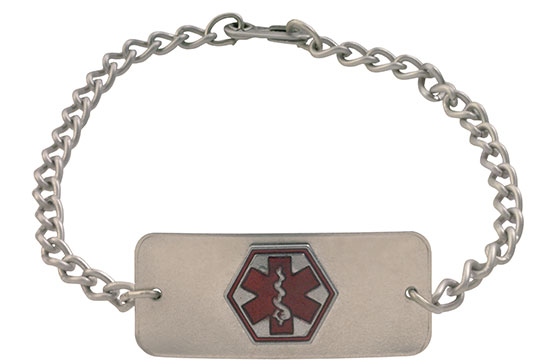
How to handle the situation:
1. It appears the man is having a diabetic attack. Since it’s impossible to know if there is too much or too little sugar, you should treat this as an extremely dangerous situation. High blood sugar levels rarely cause death, but low blood sugar is dangerous. Without sugar, brain cells die quickly and permanent damage can result.
2. The bracelet is a medical ID bracelet. It will explain what to do in case of a diabetic attack.
3. The person might be carrying some form of concentrated sugar to be taken orally. Follow the directions exactly.
4. If you can’t tell otherwise, assume the worst — that the man is suffered from low blood sugar.
5. If the man’s condition doesn’t improve right away, call 9-1-1 and describe the situation and your location.
Scenario No. 8
While visiting a friend, you notice that your friend’s father is doing some work on his computer out by the pool. Your friend’s 2-year-old brother is toddling about outside as well. When the dad’s cellphone rings, the man becomes distracted, and the toddler trips over the computer’s power cord and splashes into the pool. It becomes quickly apparent that the child can’t swim. What do you do?

How to handle the situation:
1. Do not go straight to the child! Instead, first make sure the live power cord is away from the water.
2. With the electric cord clearly away from the pool, go grab the baby.
3. With the baby out of the water, get everyone a safe distance from the pool.
4. If the child is unconscious, start infant CPR.
5. Even if the child is revived, call 9-1-1 and describe the situation and your location.
Scenario No. 9
At day camp with Boy Scouts and Cub Scouts, a Webelos Scout is working on his Totin’ Chip and ends up cutting himself on his arm. (Yes, he’s clumsy.) The boy is panicking and bleeding severely. What do you do?
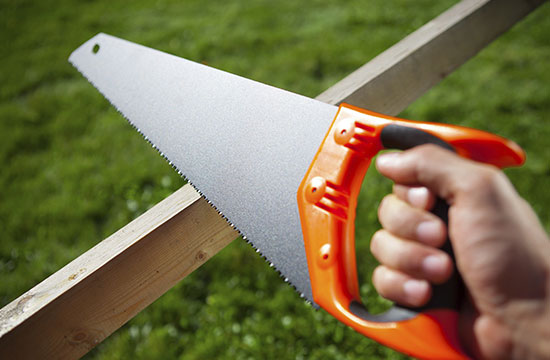
How to handle the situation:
1. Call 9-1-1 and describe the situation and your location.
2. Approach the victim cautiously and attempt to calm him.
3. Put on nonlatex gloves and eye protection if you have them. With a clean cloth or sterile dressing, use the palm of your hand to apply firm pressure directly over the wound.
4. If the pad becomes soaked with blood, don’t remove it. Instead, place a new pad on top of the old one.
5. If you have an elastic bandage, use it to secure the pad tightly over the wound. When the bleeding stops, continue to hold the pad firmly in place until help arrives.
Scenario No. 10
On a backpacking trip, you come across a small cave. From inside, you hear someone crying for help. You can see an injured individual inside the cave that appears trapped and unable to move. He says he’s dehydrated and dislocated his shoulder. What do you do?
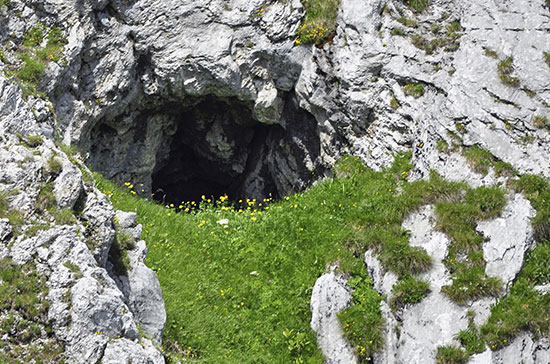
How to handle the situation:
1. Call 9-1-1 and describe the situation and your location.
2. Before entering the cave, check the scene carefully. Are there any other dangers? Are there other people in there? Approach the victim carefully.
3. Keep the victim calm. Have him take small sips of water.
4. If possible, put the man’s arm in a sling. Make sure the victim is safe from other dangers, such as falling rocks.
5. Check the victim for other injuries and keep him calm until help arrives.
Yes deez r all real y would u doubt dat.
hi i love how u do stuff like this u guys r da best.
Very useful information. I feel much more prepared now that I now how to handle these situations. Great, helpful website.
donkey laugh
Skill issue
Are these situations real?
These situations are just examples of emergencies that could happen in real life.